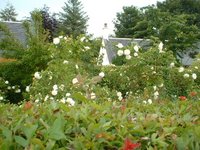

I went browsing around our local garden centre today, on my own, and realised how blissfully happy it made me. I've just sent back the revised proofs of my new book about the history of the beautiful little Isle of Gigha, which has also figured largely in my fiction, and I felt justified in treating myself to a coffee and some 'time out'. Later this week, if our current heatwave continues, I may take myself off to Culzean, or even as far afield as Logan Gardens, down in Galloway, all in the name of research for the Scottish Home (and garden, of course!)
As usual, I found myself driving home with an array of slightly battered plants which I had found on the half price trolley - a leggy Cotinus, with lovely golden foliage, and a couple of Prunus, Oshidori and Triloba. I do so love rescuing things and restoring them to useful life - textiles and plants. At the moment, they are having a long drink since they were completely dried out. I only intended to buy the Prunus (Pruni?) but the Cotinus more or less demanded to be rescued. Now I have to clear a space for them, which will prompt me to do the necessary work in my overgrown, summertime garden.
But it also prompted me to think about my favourite plants, ones which seem to characterise a Scottish cottage garden in summer. Roses come first, of course. Both I and my next door neighbour have a lovely old white Scottish garden rose called The Jacobite Rose, which is said to date from the time of Bonnie Prince Charlie. Besides that I have a Himalayan rose, Paul's Himalayan Musk, bought many years ago from rose grower par excellence, David Austin, down in England. It seems to thrive in the mild, wet climate of the West of Scotland.
Lavender is my other 'must have' - but I tend to grow them in pots. Our garden is 200 years old and the soil is a bit rich for lavenders, besides which we usually have rather a lot of rain. I grow different varieties, including the wonderful named 'fathead' in pots, so that I can keep them reasonably dry. And some of them are rather frost sensitive so I bring them into shelter (although not indoors) in winter.
I have a a huge scented jasmine, growing up the side of the house which at this time of year, July, is at its best. This originated in a tiny pot plant (another bargain) bought from a local supermarket, as a house plant. I found that it did very well outdoors, and gradually the size of the pot increased. Now, it sits on an old patio, which is covered with small and very pretty Victorian flagstones, but the roots have gone through the bottom of the pot, and through the flagstones too. At the moment it seems amazingly healthy, and the scent, which floats through my study window every evening, is wonderful, so I'm not about to tamper with it!
I love lupins too. I know people almost consider them to be weeds these days, but they are prolific, and colourful, and the smell reminds me of my childhood. And if you cut off the dead heads pretty consistently, they will repeat flower right through the summer.
One of my all time favourite summer garden flowers is the cheerful pot marigold, not to be confused with its stiffer, starchier and (in my opinion) less attractive French cousin. You should look for calendula seeds - it isn't too late to plant some even now, because they flower well into the autumn. As their name suggests, they grow very well in pots, as well as among other annuals, and if you dead head them they will flower for months. The calendula is a highly desirable herb, with lots of health giving properties - calendula ointment is particularly valued for its healing properties.
Finally borage, with its bright blue flowers, is a must. Its old name of 'bee bread' tells you how much these busy insects are attracted to it. The leaves and flowers were once used to add a cool cucumber scent and flavour to summer drinks, but - if I can find the time - I will freeze the bright blue flowers into ice cubes, one per compartment in a tray - and then keep them for Christmas. If you remember that you have them, and bring them out for Christmas drinks parties, your guests will be amazed!
No comments:
Post a Comment